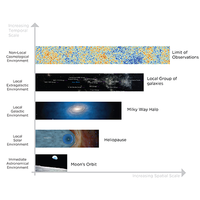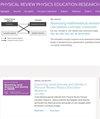Examining the mismatch between the intended astronomy curriculum content, astronomical literacy, and the astronomical universe
IF 3.6
2区 教育学
Q1 EDUCATION & EDUCATIONAL RESEARCH
Physical Review Physics Education Research
Pub Date : 2024-05-06
DOI:10.1103/physrevphyseducres.20.010135
引用次数: 0
Abstract
Over the years, there have been various calls to increase and better represent astronomy in curricula. This is motivated by views within the astronomy and astronomy education communities that the awe, wonder, and interdisciplinary nature of astronomy has the potential to engage students in STEM across disciplines. Reviews of curricula have shown that astronomy topics are represented in most mandated curricula around the world and although there is a homogeneity of astronomy topics in most mandated curricula, this representation has its limitations. By using the Australian National Curriculum, the USA-based Next Generation Science Standards (NGSS), and the Swedish National Curriculum as examples, this study unpacks ideas around “How much astronomy is enough?”, the mismatches between astronomy topics in curricula and what constitutes astronomical literacy within the context of the Big Ideas in Astronomy document. The results identify that there is a significant gap at the galactic and extragalactic scales when considering the typical progression of astronomy topics when considering the conceptual, spatial, and temporal scales of the topics. Specifically, topics in curricula jump from tangible concepts within the student’s immediate and Solar System spatial scales in primary school to cosmological spatial scales in upper high school, without reference to spatial and conceptual connecting topics at galactic scales. Potential sample curriculum statements drawn from the Big Ideas are presented as a suggested curriculum inclusion. This curricula gap is identified as a potential source of a similar gap in education research in these topics at these levels, which in turn perpetuates the problem by there being a lack of research-based evidence for inclusion in the curriculum.

研究预定的天文学课程内容、天文学素养和天文宇宙之间的不匹配问题
多年来,人们一直呼吁在课程中增加和更好地体现天文学。这是因为天文学和天文学教育界认为,天文学的敬畏、神奇和跨学科性质有可能让学生参与跨学科的科学、技术、工程和数学学习。对课程的审查表明,天文学主题在全世界大多数规定课程中都有体现,虽然大多数规定课程中的天文学主题具有同质性,但这种体现也有其局限性。本研究以澳大利亚国家课程、基于美国的《下一代科学标准》(NGSS)和瑞典国家课程为例,探讨了 "多少天文学内容才算足够?"、课程中天文学主题之间的不匹配以及在《天文学大思想》文件背景下天文学素养的构成等问题。研究结果表明,考虑到天文学课题在概念、空间和时间尺度上的典型进展,在银河系和河外星系尺度上存在明显差距。具体地说,课程中的主题从小学阶段学生身边的有形概念和太阳系空间尺度跳跃到高中阶段的宇宙空间尺度,而没有提及银河尺度的空间和概念连接主题。从 "大理念 "中汲取的潜在课程陈述样本被作为建议纳入的课程。这种课程差距被认为是在这些级别的这些主题的教育研究中存在类似差距的潜在根源,这反过来又由于缺乏纳入课程的基于研究的证据而使问题长期存在。
本文章由计算机程序翻译,如有差异,请以英文原文为准。
求助全文
约1分钟内获得全文
求助全文
来源期刊

Physical Review Physics Education Research
Social Sciences-Education
CiteScore
5.70
自引率
41.90%
发文量
84
审稿时长
32 weeks
期刊介绍:
PRPER covers all educational levels, from elementary through graduate education. All topics in experimental and theoretical physics education research are accepted, including, but not limited to:
Educational policy
Instructional strategies, and materials development
Research methodology
Epistemology, attitudes, and beliefs
Learning environment
Scientific reasoning and problem solving
Diversity and inclusion
Learning theory
Student participation
Faculty and teacher professional development
 求助内容:
求助内容: 应助结果提醒方式:
应助结果提醒方式:


